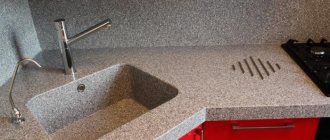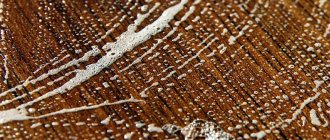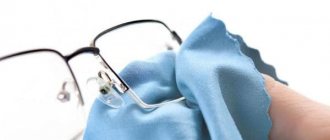May it serve for a long time!
Sinks made of artificial stone have recently become especially popular in the domestic market. This is due to the unique characteristics of the material from which they are made. Artificial stone is produced on the basis of natural mineral components with the addition of resin and coloring agents. It has a dense, homogeneous structure, has high strength and moisture resistance, is resistant to high temperatures, ultraviolet radiation, chemical reagents, and has good hygienic characteristics.
We talked about the pros and cons of artificial stone sinks, as well as the selection criteria, in a previous article. Now we will talk about how to extend the service life of the purchased product.
Features of cleaning a stone sink in the kitchen
The stone sink in the kitchen should be cleaned daily, after washing dishes. Basic rules of care for every day:
- There should be no food residue left in the sink;
- Regular use of soap or dishwashing detergents;
- Treat the surface with a sponge or soft cloth made of natural fibers and soap foam;
- Rinse off any remaining detergent with warm running water.
Regular and proper cleaning will prevent the formation of stubborn stains and mildew.
Once a week, you need a more thorough cleaning of the stone sink in the kitchen and disinfection with products containing chlorine - Domestos, Belizna, which are distributed over the bowl, left for 10 minutes and rinsed.
Every month, wash your stone kitchen sink with dishwasher tablets, which are dissolved in water to a mushy state, applied to the surface, left for half an hour, rinsed off and wiped dry.
To clean a stone sink in the kitchen, the main rule is that it is forbidden to resort to too aggressive cleaning, use organic solvents, acids, rough brushes, metal sponges, products with large abrasive substances, and also do not rub the surface too hard. For cleaning, soft sponges are used, which remove dirt without damage and restore shine.
Do I need to clean and how often?
The sink is an indispensable attribute of any kitchen. The best sink option for housewives is stone sinks. Due to their mass and density, they have good sound insulation. A stone sink is much quieter than a metal sink. The color can easily be matched to the color scheme of the kitchen or bathroom.
The highest quality manufacturers of sinks made of artificial stones:
- Franke, Sweden. For miniature kitchens. Install the sink into the countertop.
- Blanco, Germany. Installed in kitchen cabinets, suitable for both small and spacious kitchens.
- Lava, GranFest, Portu, Russia. There are mortise installations. The functional wing makes washing dishes easier.
To avoid noticeable stains, it is better to purchase a sink with a pattern - this will make it easier to care for.
Such sinks have a huge number of advantages. But of course there are also disadvantages - high cost and careful maintenance. Not everyone is ready to put all their effort into cleaning and cleaning the sink. Compliance with many rules of cleanliness and care will help the stone sink to be in good condition for many decades.
Chemicals for cleaning stone sinks in the kitchen
Dirt accumulated on a stone sink in the kitchen, stubborn stains, stains can be washed off using household chemicals marked for composites, which are used according to the instructions on the package. This group includes several professional compositions:
- Special products for composite stone sinks, for example, Schumanite, Cillit Bang universal spray, Akemi cleaner;
- Chlorine-containing compounds effectively wash away plaque, grease and dirt, beetroot, coffee, tea stains, and also have a disinfectant effect, killing fungi and microbes - Belizna, Domestos;
- Dishwashing liquid is used for daily care and to prevent stains, especially if the composition contains natural ingredients. Soap cleans the stone without leaving a waxy film on the surface. A soap solution removes coffee, tea, and wine stains;
- Melamine sponges perfectly remove lime and salt stains and rust stains from stone sinks in the kitchen thanks to the small crystalline particles in their structure. No aids are needed during operation. To clean the kitchen sink, rub it with a sponge, let the surface dry, and rinse it 2-3 times with warm water. Apply a few drops of vegetable oil to a cotton pad, rub the bowl of the kitchen sink until shiny, leave for 7-10 minutes, wipe with a dry cloth made of natural fibers;
- To clean stubborn dirt from a stone sink in the kitchen, use chlorine lime. To do this, fill the sink with water, add 2 tablespoons of powder, stir, and leave for half an hour. Then the liquid is drained, everything is thoroughly washed and dried;
- For white and light stone kitchen sinks, bleach is suitable, which removes dark stains from tea, coffee, beets and other colored juices. Remove all excess from the bowl, close the drain, fill with hot water, add 2-3 cups of white, leave for about an hour, open the drain hole, wipe the surface dry.
On a note! To clean a stone sink in the kitchen, household chemicals in the form of gels or creams with a gentle effect on the surface are suitable. The well-known Comet and Pemolux powders can also be used, bringing them to a mushy state so as not to scratch the coating.
Terms of use
Of course, you need to know how to clean a capricious stone sink. But it is equally important to follow simple instructions for its use. Despite the fact that stone plumbing has a fairly high density and strength, there are still a number of recommendations for its careful operation.
- You should be careful with sharp and heavy objects when washing them. For example, even an unintentional drop of a knife can cause a chip or crack.
- Products made of ceramic material are also extremely sensitive to temperature changes - it is worth washing dishes exclusively with warm water, smoothly switching from cold to hot. It’s also not a good idea to put pots and pans in the sink straight from the stove.
- You cannot pour boiling water into such a sink without turning on cold water at the same time.
- It is not recommended to use the surface as a cutting board - over time, defects will appear on it that will be difficult to remove.
- It is not advisable to keep dirty dishes in the sink for a long time. This is especially true for a beige or white stone sink - it will quickly become covered in various shades of yellow.
Tip: if you use a cleaning agent in powder form for a composite surface, then moisten it with water until it becomes a paste - this way you can reduce the abrasive effect on the plumbing material.
Folk remedies for cleaning stone sinks in the kitchen
Before purchasing special products for cleaning a light or dark stone sink, you can try to wash it using folk recipes, the ingredients for which are found in every kitchen:
- Lemon is a universal remedy that removes white limescale, tea and coffee stains, dried food residues, and gives a fresh aroma. In case of severe contamination, rub the surface with the squeezed juice, leave for 20 minutes, and rinse with clean water. Citric acid also effectively removes stains. To wash away stubborn dirt, close the drain hole with a stopper, take warm water, add 50 g of powder, leave overnight, drain the liquid in the morning and wipe with a rag;
- Baking soda perfectly removes dark coffee stains, salt and grease deposits. To prepare the mixture, pour a few tablespoons of soda powder into a clean container, dilute with water to make a paste, wipe the bottom and walls of the stone sink with a sponge, leave for 10 minutes, then rinse;
- Mustard powder works well for removing grease deposits and fresh stains on the walls of a stone sink in the kitchen. Mustard is first diluted with water to a mushy state, applied to stains or the entire surface of the sink, left for 30 minutes, washed off with clean water;
- Carbonated drinks Sprite and Coca-Cola contain phosphoric acid, which perfectly cleans plaque and any dirt. To clean a stone sink, close the drain, pour in soda and leave for half an hour to an hour. Periodically wipe the walls and wings of the sink with a sponge soaked in a drink;
- Gel toothpaste is used to clean rust stains and whiten stone kitchen sinks. Simply rub the stains with a sponge and then rinse with water. A bleaching paste, which is rubbed into the stains and left for half an hour, then wiped with a rag soaked in vinegar will help restore the whiteness of a light stone sink;
- Table vinegar will help clean the kitchen sink of rust, lime and unpleasant odors. Vinegar is pre-diluted with water in the following proportions: 1 part of a 9% solution requires 2 parts of water or 1 part of acetic acid to 10 parts of water. A sponge is moistened in the resulting solution and rubbed onto all surfaces of the stone sink in the kitchen. More stubborn stains are wiped with the rough side;
- Chalk will help remove stubborn stains from a stone sink in the kitchen. To do this, it is diluted with hydrogen peroxide, the resulting slurry is applied to the surface and covered with cling film or tape to create a greenhouse effect. The chalk is removed and the sink is treated with clean water.
What is the difference between artificial stone and acrylic sinks?
There are some minor nuances in caring for agglomerate and acrylic countertops.
First we need to clear up the confusion created by marketers. From a distance, both artificial materials resemble natural stone and look great in the kitchen interior. Before you wash a “stone” sink, you need to make sure what you are dealing with. For example, if the kitchen set was inherited from the previous homeowners.
Acrylic-based artificial stone | Agglomerate |
| Warm to the touch | Cools to the touch |
| Glued onto a chipboard backing | Without backing, plate thickness 2-3 cm |
| Seams and joints are not visible | Joints are visible up close |
Boiling water of 100 degrees C will not cause damage to a sink and countertop made of agglomerate. The manufacturers themselves do not recommend pouring boiling water into an acrylic stone sink.
A case from one's life. Following this advice, the housewife poured the pasta and potatoes into a special metal basin. It stood next to the sink right on the acrylic countertop. After some time, a cloudy spot appeared under the basin.
How to Remove Scratches from a Stone Kitchen Sink
Improper use or careless maintenance of a stone sink in the kitchen contributes to the formation of scratches on the surface, which spoil the appearance and create obstacles when cleaning the bowl. Small cracks can be repaired yourself at home:
- A stone kitchen sink with a matte finish is wiped with the rough side of a sponge with baking soda applied and washed off with water. For deeper scratches, use sandpaper No. 240, which is used to carefully process the damage, and for final grouting - No. 80;
- On a glossy stone kitchen sink, small cracks are treated with liquid with ammonia and wiped with the soft side of the sponge in a circular motion, then the product is washed off and the sink is dried. Then a special polishing mixture without silicone additives and citrus extract is applied to the surface. For deep damage, you will have to use a grinder with different attachments.
How to clean stubborn stains from a kitchen sink
After prolonged use, dirt remains on the surface of a stone sink in the kitchen, which is difficult to clean. It seems that the appearance of the sink is ruined, but there are recipes that will help cope with the problems:
- You can remove white limescale from a stone sink in the kitchen using household chemicals for composite surfaces. The bowl is treated with a wet sponge, a cleaning agent is applied, no additional exposure is necessary. After a few minutes, the liquid is washed off;
- Rust can be easily washed off with regular soda. It is recommended to take clear drinks. The liquid is heated, poured into the bowl, left for 10-15 minutes, then begin scrubbing; in difficult cases, the procedure is repeated several times. Ammonia and hydrogen peroxide will help clean a stone kitchen sink from rust. The components are mixed in equal proportions and applied to the contaminated area. When mixed, a chemical reaction occurs that is responsible for cleaning the surface;
- Alkaline solutions will help remove traces of tea and coffee from a stone sink in the kitchen. Instead of intensively rubbing the surface, the contaminated areas are smeared with lemon juice, left for 2 hours and treated with a clean, dry cloth.
What not to do
To use it successfully, a person must know simple rules. If you adhere to them, the product will last a long time. Things to remember:
- You should not start cleaning with the use of chemicals. In some cases, using a soft sponge and soap is sufficient.
- Hard sponges and brushes leave behind scratches in which food gets clogged over time.
- Baking soda is the first cleaning product that is always on hand. If it does not help in cleaning the product, they move on to using more aggressive agents.
- Food remains cannot be scraped off with sharp objects.
- A substance containing aggressive components should not be in prolonged contact with surfaces.
- Protect a light-colored sink from coffee and tea stains. Also avoid contact with liquids containing coloring pigments. Even if drops get on the surface, you should wipe them off immediately.
A broken faucet can contribute to the appearance of limescale. A stream of water constantly flowing over the surface leaves behind rust stains. Therefore, the tap must be repaired. It is not recommended to throw heavy dishes into the sink. Blunt impacts contribute to the appearance of cracks.











